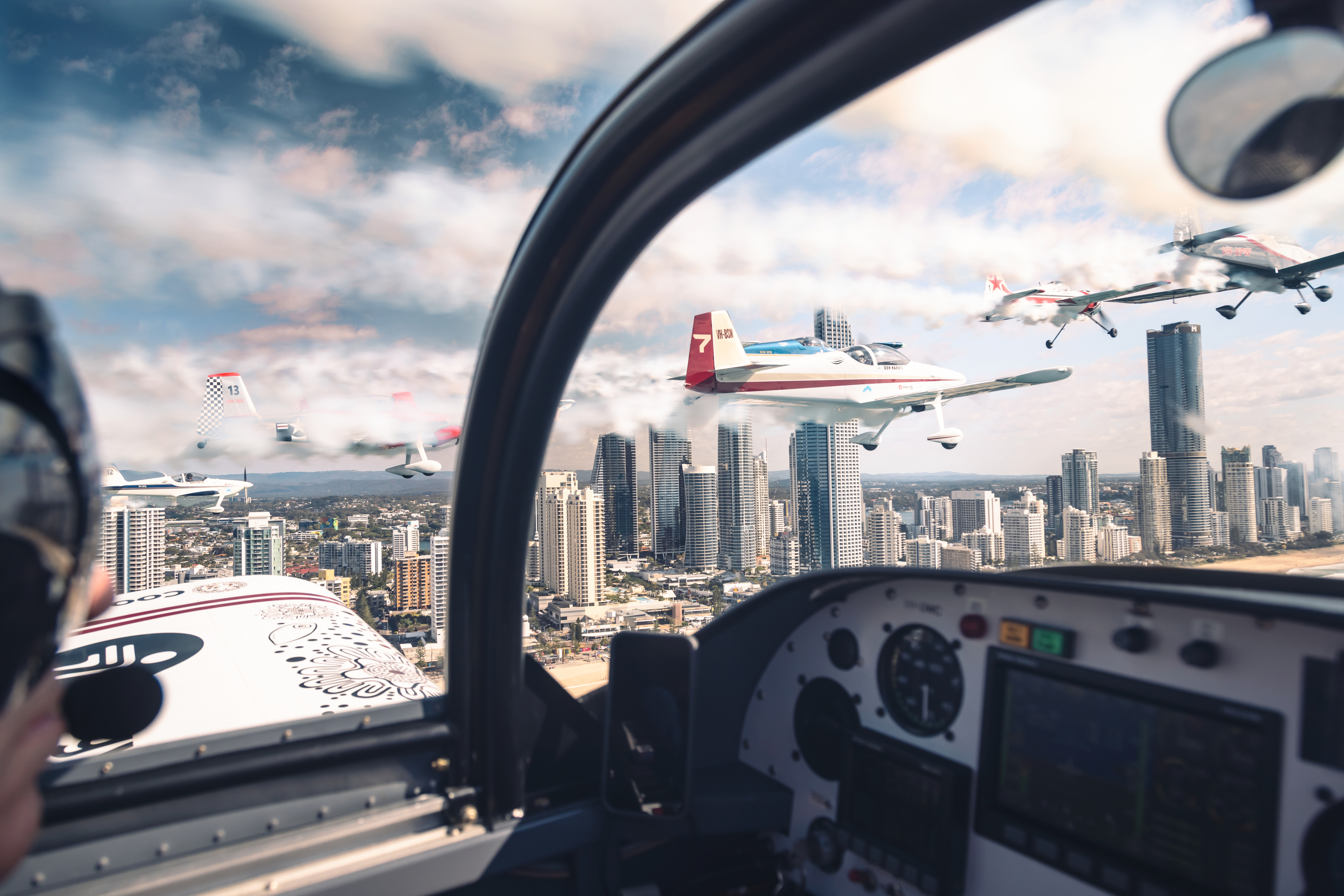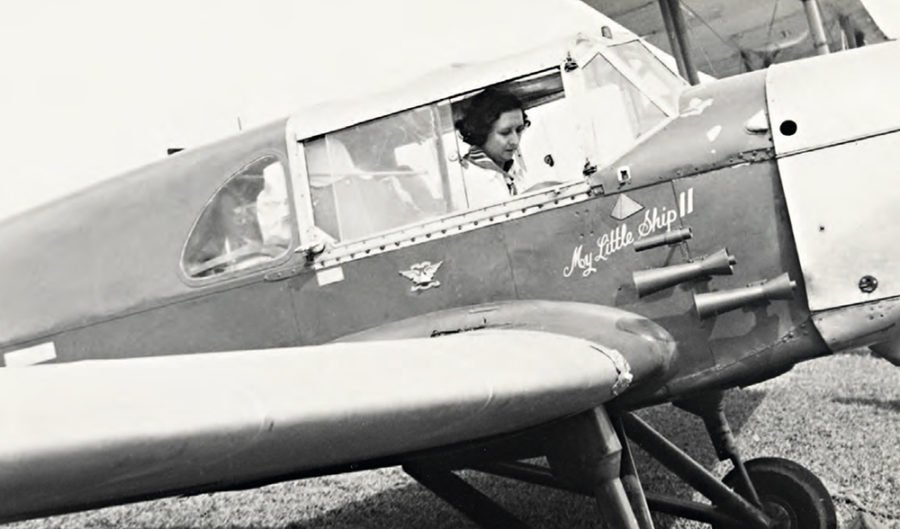It could be any ordinary day on Queensland’s famous Surfers Paradise beach – sparkling water, warm, golden sand, children shrieking and jiggling in the whitewash, hundreds of colourful umbrellas swaying precariously on thin poles nearby. But today is far from ordinary. A loudspeaker crackles to life: “Here they are, ladies and gentlemen!”
Way above the shimmering skyscrapers, 13 small planes launch into a spectacular sky-high, synchronised dance. For more than 10 long minutes, the single-propeller aircraft leap and twirl in perfect unison, trailing long ribbons of smoke behind them. With sleek bodies glistening, their wingtips are no more than a few metres apart.
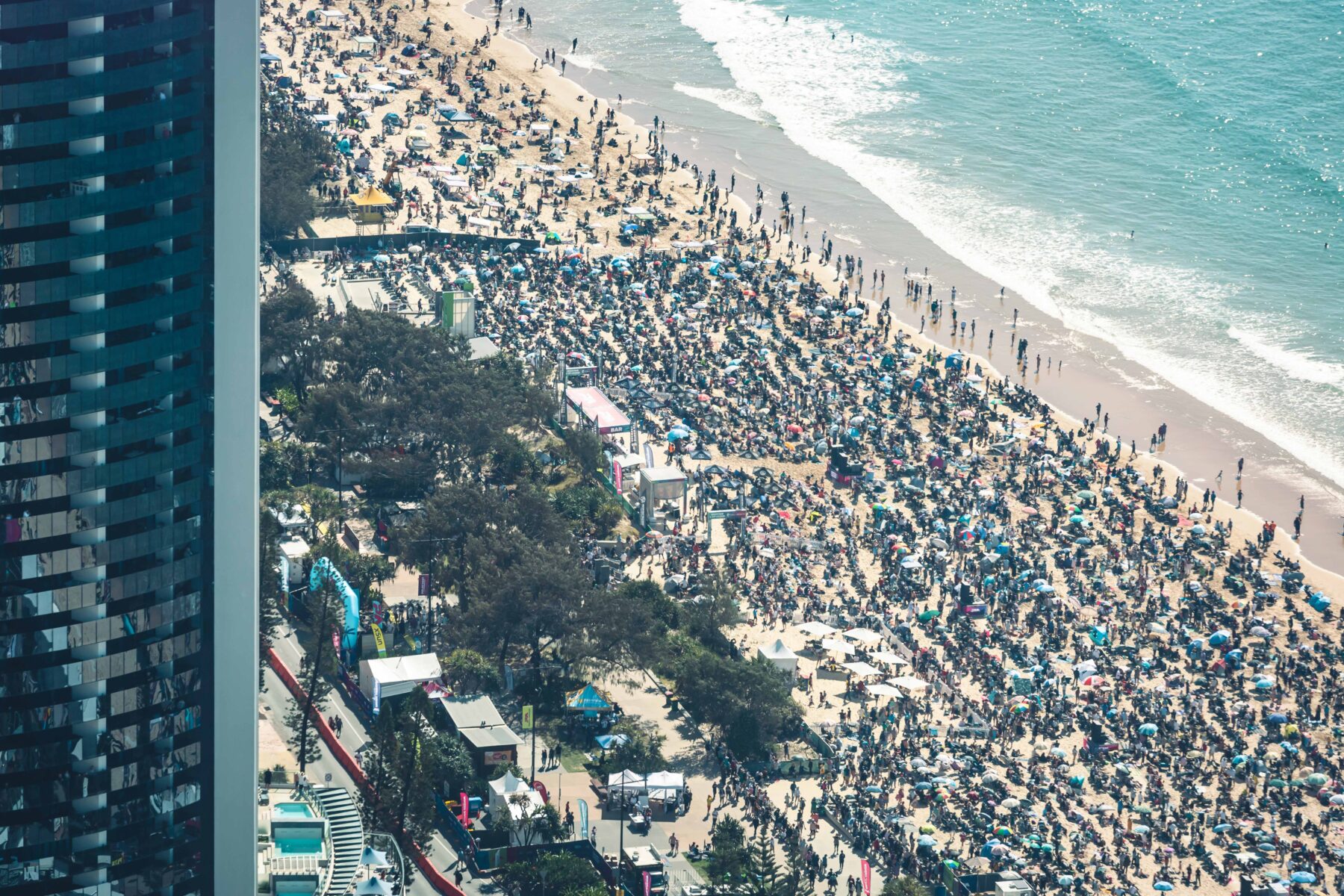
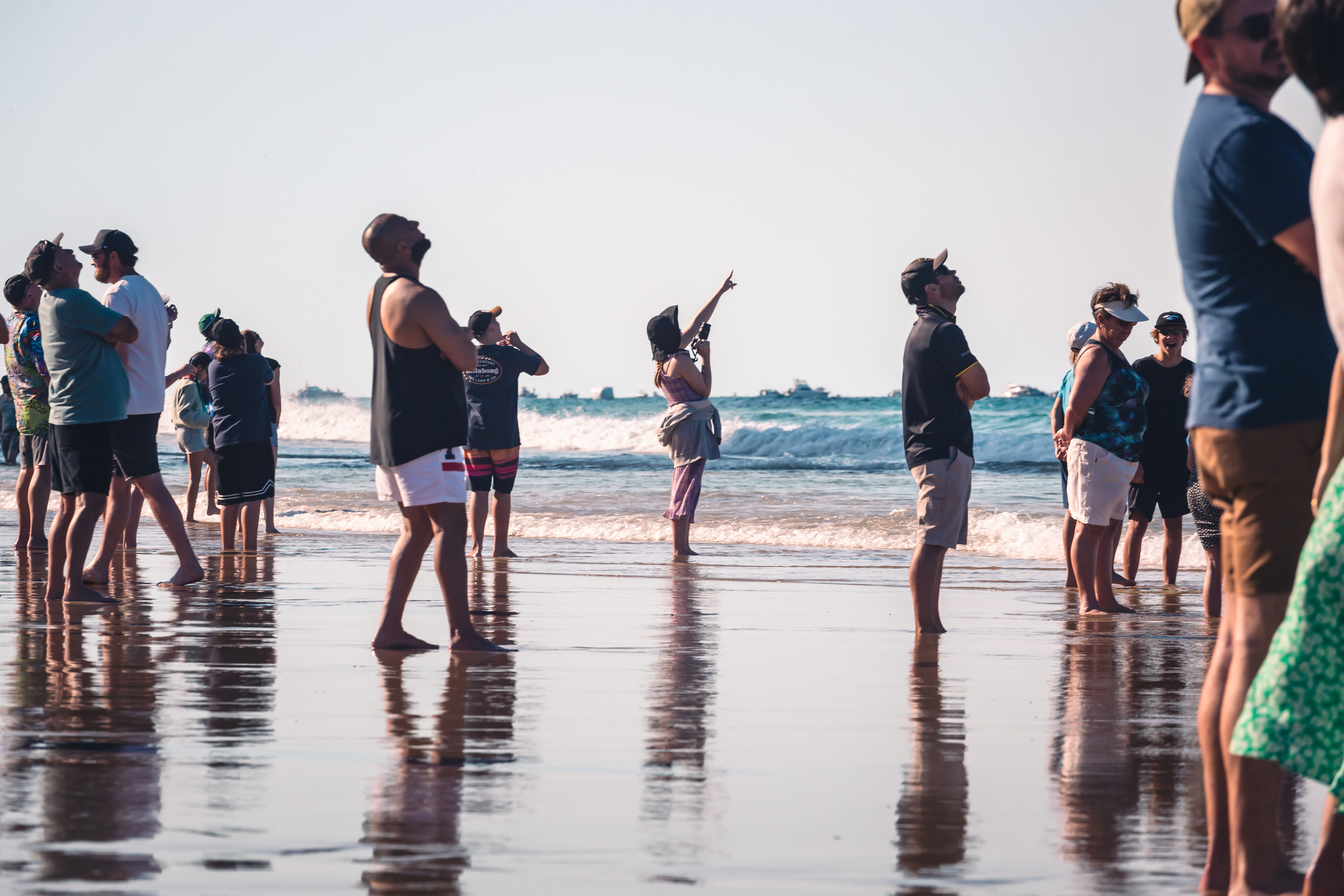
“Here comes the pass!”Two planes hurtle towards each other, head-on. From my sandy seat, I can barely watch. My stomach churns, convinced I will bear witness to some devastating air disaster. At the last second, the planes each deftly flip onto a wing, their bellies streaking past each other and missing by a whisker.
This is the Freedom Formation Display Team, an Australian troupe of daredevils who present just one of the acts on the sky-high stage of the Pacific Airshow on the Gold Coast. Astoundingly, these pilots are amateurs. Most of their planes were built in garages and sheds across the country, by the pilots themselves.
The Pacific Airshow was established in 2016 at Huntington Beach in California. For the first time, its organiser, Kevin Elliott, has spread his wings to bring the show to Australia’s Gold Coast. The Glitter Strip’s beating heart, Surfers Paradise, is the dramatic backdrop – shining skyscrapers stand shoulder to tall shoulder along the beach and the crystal-clear waters of the Coral Sea. For three days, more than 300,000 eager spectators take over the sand, and the many balconies above, to watch displays by the world’s best stunt pilots, military aircraft fly-pasts and formation flying. It’s Australia’s largest airshow and it won’t be the last – the organisers have locked in the next four years to temporarily take over the Surfers Paradise skies.
The soul of the Freedom Formation team is the lead, Jeremy Miller, who taught all of the pilots in the group how to fly formation and is responsible for their safety. It’s his choreography they perform in the 1.5km “performance box”.
Six years ago, Jeremy was flying for the Royal Flying Doctor Service in Broken Hill in New South Wales when a mate called to see if he would teach four keen amateurs in Sydney how to fly in formation. “One of the wives said they were ‘stooging around on the weekend’, so those four pilots became the Stooge Formation,” Jeremy says, laughing. “They became friends and brought other pilots in. Then, when the Pacific Airshow was announced, one of the pilots, Eddie, said, ‘Do you reckon the Stooges could do the Pacific Airshow?’ and I thought, That’s a good idea.”
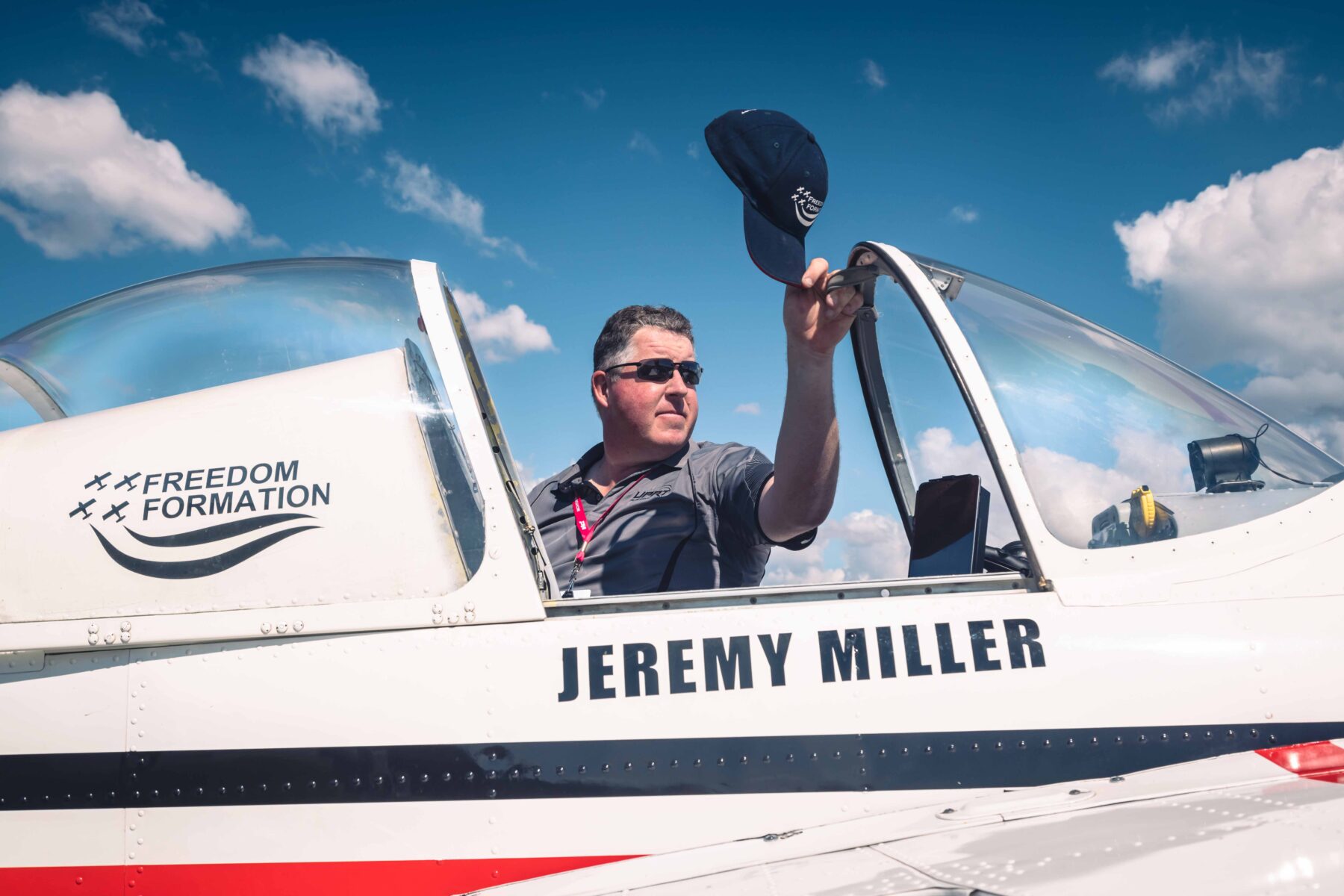
The group expanded to 13 planes – with Jeremy in the lead – and the rigorous training began. More than 200 hours of preparation would go into pulling off a 13-minute show almost 12 months later. There were multiple, three-day-long training camps, where they would be fully briefed, walk through the routine on the ground and then take off for an airborne rehearsal.
“Formation flying seems really dangerous, but it’s actually quite a safe activity,” Jeremy says. I laugh – on the ground it looks as though one small error could spell death at each turn. But he doesn’t falter. “A lot of briefing and a lot of training goes into getting them up to that standard of performance,” he says. “There are no surprises, and once you’re on the same page, it’s actually quite easy. I liken it to a stage show – everyone knows their part.”
Jeremy says it wasn’t difficult to convince the Pacific Airshow organisers to let a bunch of amateurs in homemade aircraft be on the bill. “From [the Airshow at] Huntington Beach, they know that crowds love formations, where there’s lots of aircraft in the air at once – and they bloody loved it.”
When crafting the choreography, Jeremy says his objective was to “fill the Gold Coast with smoke”. “Which we did,” he says with a smile. “Second, I wanted to design a display where people didn’t know where to look, where there were lots of different elements going on.” The final piece includes a Balbo formation – where all 13 planes fly together, within metres of each other, and then split off to perform solo acrobatics. The team pulls off tail chases, rolls and loops. From the beach, the crowd collectively “aaahs” as a pair of planes etch a huge heart shape that lingers in the blue sky before the breeze gently pulls it apart.
It’s not all grace and beauty – the whole show is carefully balanced, and it’s all up to Jeremy. “As the formation lead, my job is to run the whole show,” he says. “I tell the guys what’s happening next and when they need to break out of formation, but my biggest role is to keep everyone safe. The guys are trusting me to fly at the right speed and height, and they just follow me. I’m like the conductor of an orchestra. One small mistake from me can create major issues for them, so I have to fly exactly the same as I did in practices, which is difficult to do – to have that consistency of flying. But that’s the challenge of leading.”
On the beach, it’s not just the so-called av nerds that have travelled far and wide to take in the spectacle. It’s a true family affair and an event where harassed parents don’t have to corral kids to sit still – they run, splash and dig, stopping in awe to gaze skywards to take in the roaring planes overhead. Territory is marked by camp chairs, umbrellas and towels, while others dig out impromptu “sand sofas”, complete with backrests.
Where the sand turns to esplanade, a temporary tower has been set up where the voice of the airshow, MC Matt Jolley (imported from the Californian edition) is located. A ritzy cabana with rows of bright white seats has been erected so VIPs can enjoy refreshments in the shade, while still being front and centre to all the action.
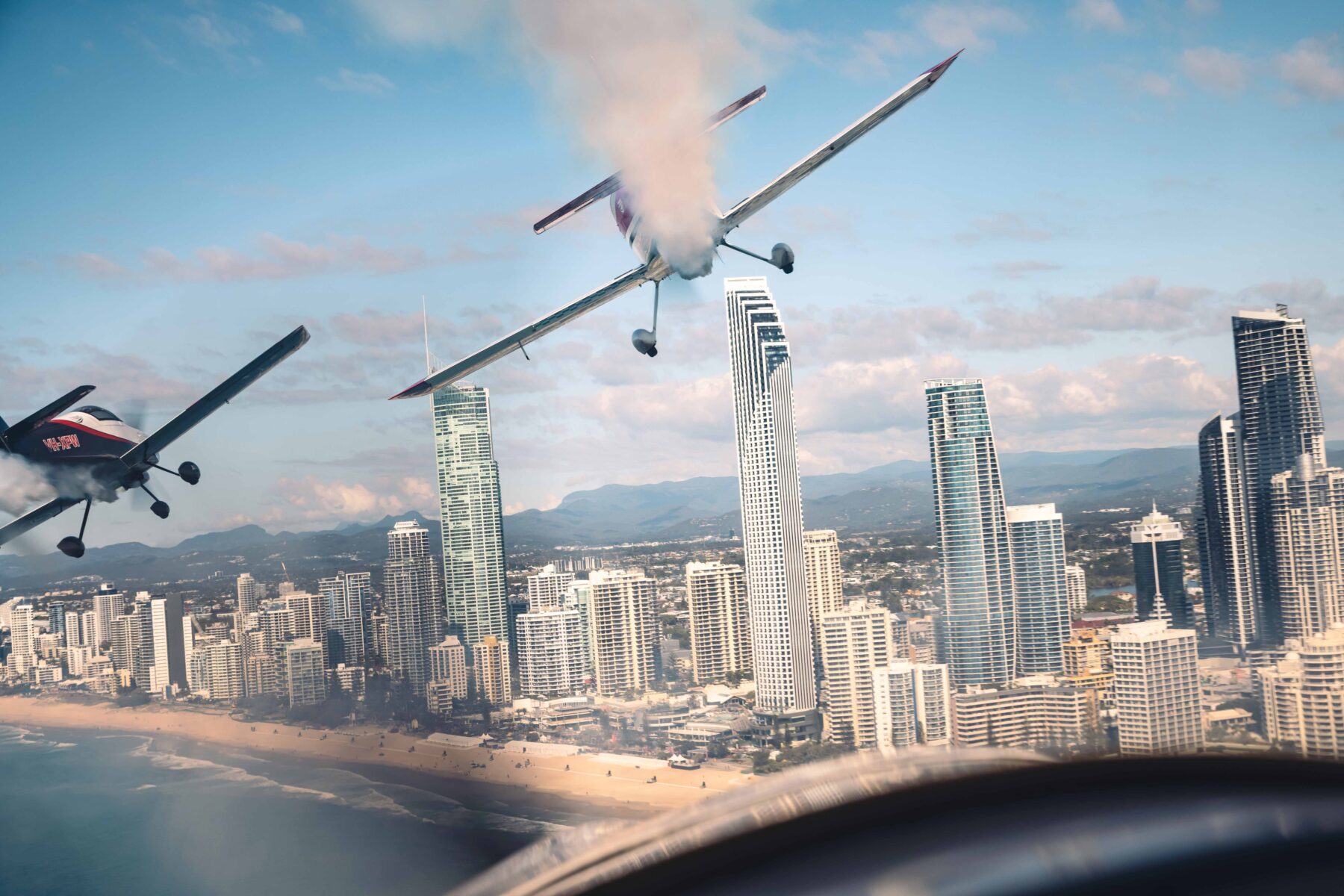
Among them is 99-year-old Adelaide man Henry Young. For Henry, watching the fighter jets and listening to the comms between the flight deck and the MC sends him spiralling through time, back to when he was a starry-eyed teenager signing up to fly in World War II. He was born in Australia but was in New Zealand when war was declared. He enlisted in the Royal Navy’s Fleet Air Arm when he was just 18 years old. “I think everybody at that age wants to be a pilot,” he says with a twinkle in his eye. “New Zealand was the only empire country that provided pilots to the Royal Navy. I jumped through all the hoops before I was ready to go, and I shipped straight to England.” From there, he was put on another ship to the USA, where he earned his stripes.
During his time in service, Lieutenant Young flew aircraft ranging from the Boeing Stearman to the Navy’s version of the Supermarine Spitfire, the Seafire and the Hawker Sea Fury.Despite the dangers, Henry says his time as a WWII pilot was a “wonderful experience”. “I loved it,” he enthuses. “Most people who fly get it in their blood.” Henry’s niece invited him to the airshow and word got out that a WWII pilot was in the crowd. Henry was astounded by the star treatment he then received. Dapper in a grey suit and perfectly pressed blue-and-white collared shirt, he is loving every minute, a smile never leaving his face.
So, how do the planes compare with the ones he flew nearly 80 years ago? “It’s tremendous. I can’t get over the increase in power,” he says. “It takes me back because I was in the aerobatic team and I could see the skill that was there at the show. There have been so many advances in aviation since I was a boy. To an old pilot, it’s wonderful to see.”
“You can play in the clouds – it’s wonderful when you’re diving down into the chasm of a cloud and doing twists and turns…it’s exhilarating.”
Spectator, Henry Young
Henry says the best part of being a pilot is that “You get to paddle your own canoe. You’re in charge and you can do all these things that earth-bound people can’t do.
“You can play in the clouds – it’s wonderful when you’re diving down into the chasm of a cloud and doing twists and turns and you can’t hurt yourself. You can’t see and it’s exhilarating. I just miss it so much…as does anyone who hasn’t flown for any length of time,” he says wistfully.
Henry’s flying career came to an end when he fell in love. “I met my good wife, and when I proposed I said, ‘You can have me as an airline pilot, or as a farmer.’ She said, ‘I think I’ll have you as a farmer – if I have you as a farmer I’ll see more of you.’”
It’s the brotherhood Henry misses most about service. “In the Navy you live and eat and play together; you’re all in one group. It’s the camaraderie that you never forget. I’m the last of my squadron still alive. Nevertheless, it’s nice to be here,” he says.
The heavy bass and frantic guitar riffs of Guns N’ Roses’s “Welcome to the Jungle” blare from the towering stack of speakers, but it’s nothing compared with the deep rumble approaching from the north. Gliding through the air is the
MV-22B Osprey, a tiltrotor aircraft. The Osprey has propellers on each wing and can physically rotate mid-flight, enabling it to hover like a helicopter or fly like a jet.
Matt Jolley radios in to the Osprey’s flight deck as it hovers over the water, the propellers churning up a circle of swirling mist. The aircraft neatly pivots in a slow, tight turn.
MC: “I can feel you today, Smeagol, I can feel the wind.”
Smeagol: [crackle] “It’s gale force out here.” [crackle]
MC: “There goes a beach umbrella, sorry about that. There ya go. All part of the fun out here at the Pacific Airshow. I tell you what, ladies and gentlemen, we’re having a good time and I hope you are too. Smeagol is going to crank it up here for you, ladies and gentlemen, and show you just how he can dance.”
The dancing, it turns out, comes from stage left, to the tune of Roy Orbison’s rockabilly classic, “Oh, Pretty Woman”. The Osprey twirls in a series of perfect pirouettes.
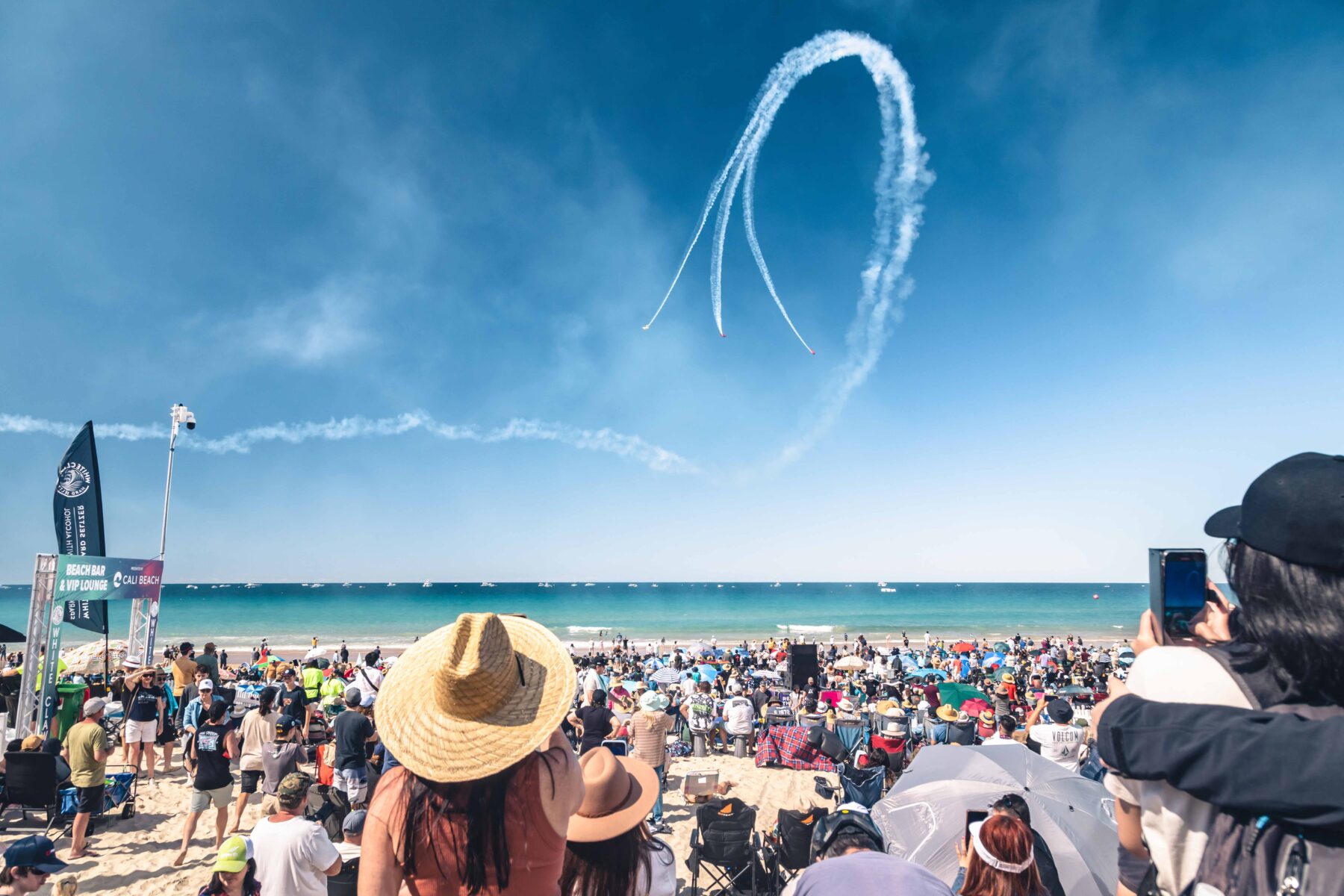
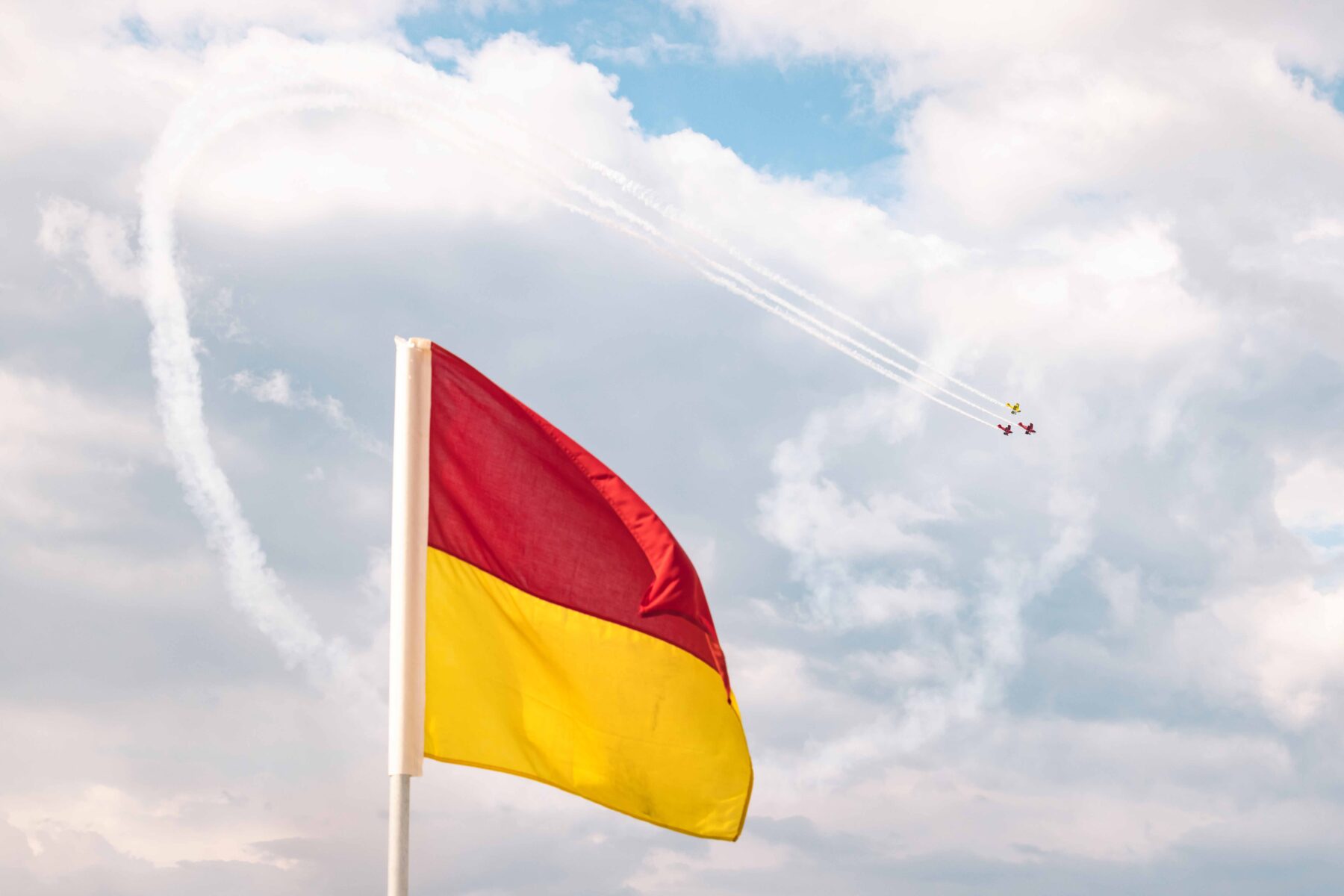
The sun has dipped behind the skyscrapers. The shade creeping across the sand brings relief from the heat. After four hours of non-stop action, it’s time for the headline act: the F/A-18F Super Hornet. Its sleek grey body can reach speeds of almost 2000km/h. It can attack – and be gone – within seconds. And it’s deadly, loaded with missiles, bombs and nose-mounted guns (none of which are present at the airshow). But today, the crowds marvel at its speed – and ear-splitting noise. The jet streaks past, the deafening roar chasing it seconds later.
For the armed forces, the Pacific Airshow is part spectacle and part recruitment drive. Tents are set up along the heaving esplanade with dashing pilots in flight suits, complete with ready smiles, to answer any questions from starstruck hopefuls whose pulses have been set racing by the sheer power and might they’ve just witnessed.
It was the sight of a such an Air Force pilot in a flying suit that caught the eye of a young Aarron Deliu. At the time, Aarron was a teenager with little interest in school. But a serendipitous meeting at a careers day changed the course of his life. Now, resplendent in a flight suit himself and with all the confidence and charm of Top Gun’s ‘Maverick’, Aarron says talking to the pilot propelled him to knuckle down and catch up on six months’ worth of schoolwork so he could start earning his pilot’s licence. His first solo flight was in a glider, when he was just 14.
“We landed and my instructor opens the canopy, but tells me to keep my seatbelt on,” he says. “He hops out and he goes, ‘Have a good flight.’ I just remember it felt like home. I was 14, I hadn’t driven a car, and now I’m in an aeroplane by myself, flying around, thermalling. I just got goosebumps remembering it.” Aarron rubs his arms and grins at me. “It was amazing. Suddenly you realise how capable you are. Because up until that point, I think I was very reliant on everyone. It was a big maturing moment for me and I grew up quite rapidly.” And the landing? “Nailed it,” he says with a grin. “As we say in the industry: ‘butter’.” Meaning, perfectly smooth.
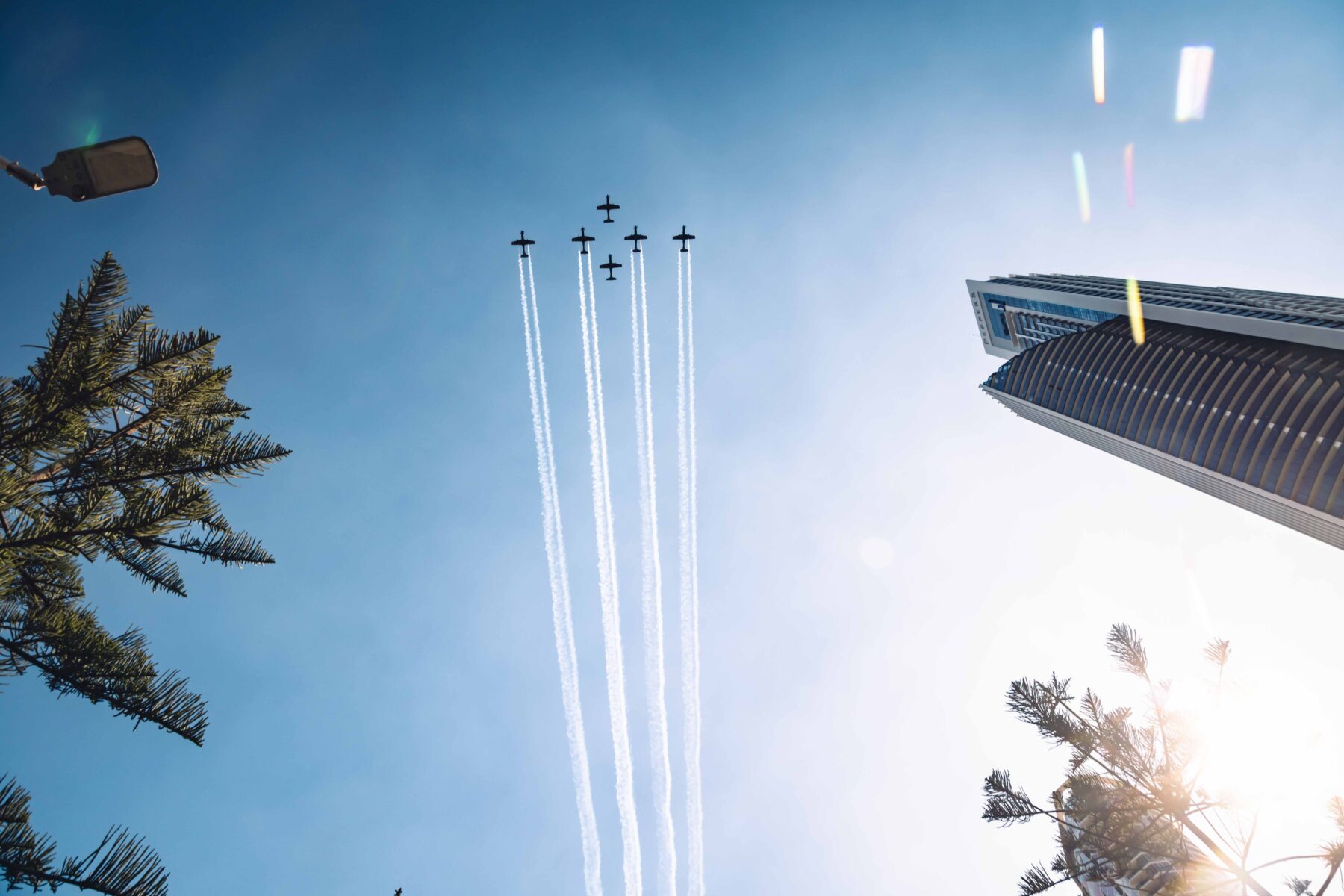
But his dream of becoming a fighter pilot soon changed – his sights became set on thrills of a different kind. “The idea of being a fighter pilot gave me focus – but this is the cool part. I got called up to get sponsored to do aerobatics. I was in the right place at the right time, having someone wanting to pay me to be an airshow pilot and I was like, ‘Yes, let’s do it’. And the rest is history.”
Alongside his airshow and aerobatics, Aarron is an aircraft instructor and business jet pilot. He has type ratings in multiple aircraft types including fighter jets, helicopters, race and aerobatic aircraft and seaplanes. He has travelled the world as an aerobatics and airshow pilot, earning accolades along the way, including the Sky Grand Prix Champion and the Australian Unlimited Aerobatic and Freestyle Champion.
In the Pacific Airshow, the former Perth local hopes his 10-minute solo stops people in their tracks. “I just want them looking and thinking, ‘How the hell?’ and having their jaws drop. I hope I’m giving that to an Australian audience.” What does he love about performing in airshows? “I hope that I could inspire one person, one kid, who’s just figuring out life, who then starts doing lessons,” he says. “I met a pilot and aviation changed my life so much. To know that possibly for just a brief moment, a millisecond, you can change someone’s trajectory in life…to me, that’s really special because that’s what happened to me.”
Cruising into the display box in a straight flypast, the Yak 110 looks like a normal plane. With a deft flip, it peels away – and then shows its true colours. Nicknamed the ‘Frankenplane’, the Yak 110’s creator is American pilot Jeff Boerboon, who came up with the idea of “sewing” two Yak 55 acrobatic planes together and dropping in a spare GE J85 jet engine to give it life. The two planes share a fabricated centre to join the two fuselages, as well as the pairing of the horizontal stabilisers and trimmed outboard horizontal tails. While both single-seat cockpits are fully operational, the twin-prop plane needs just one pilot to get it airborne from its four wheels.
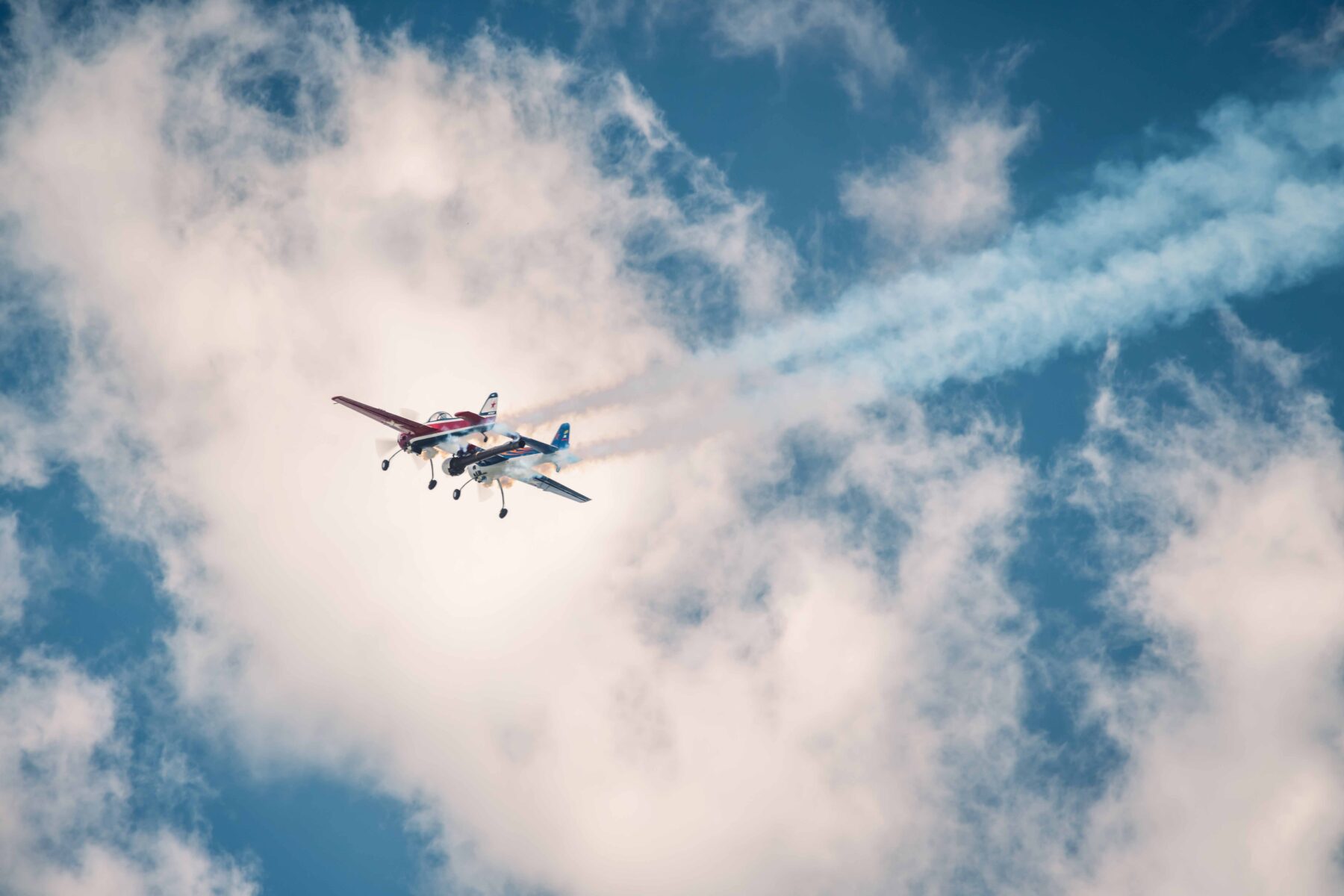
The mutant plane, its wings emblazoned with the Star-Spangled Banner, is a crowd favourite. To the beating bass of “The Greatest Show”, Jeff Boerboon – the great aerobatic showman himself – sends the Yak 110 into a spiral, twin plumes of blue smoke trailing in its wake over the rolling waves below.
“Here comes the second hammerhead,” booms Matt Jolley’s voice over the speaker. “Jeff Boerboon doing the impossible today with the Yak 110. He’s gonna have a little fun.” A hammerhead begins with a loop into vertical climb until the plane runs out of speed. It hangs in the air for a moment before pivoting 180 degrees into a nosedive. It finishes with a flourish, with another half-loop.
For almost four years, the cars at Eddie Seve’s house were parked outside as his garage became a mechanic’s workshop. He had ordered a kit plane from Vans Aircraft in the USA, and would come home from work to spend a couple of hours each night assembling his aircraft. Kit planes cost upwards of US$28,000 and arrive flat-packed, in boxes upon boxes. “There are thousands of components,” Eddie says.
However, he reckons building a plane is something anyone can learn to do. The Freedom Formation pilot has now built three and is one of the so-called tech counsellors, for the Sport Aircraft Association of Australia, who are called to inspect workmanship before a Civil Aviation Safety Authority Approved Person decrees the project airworthy.

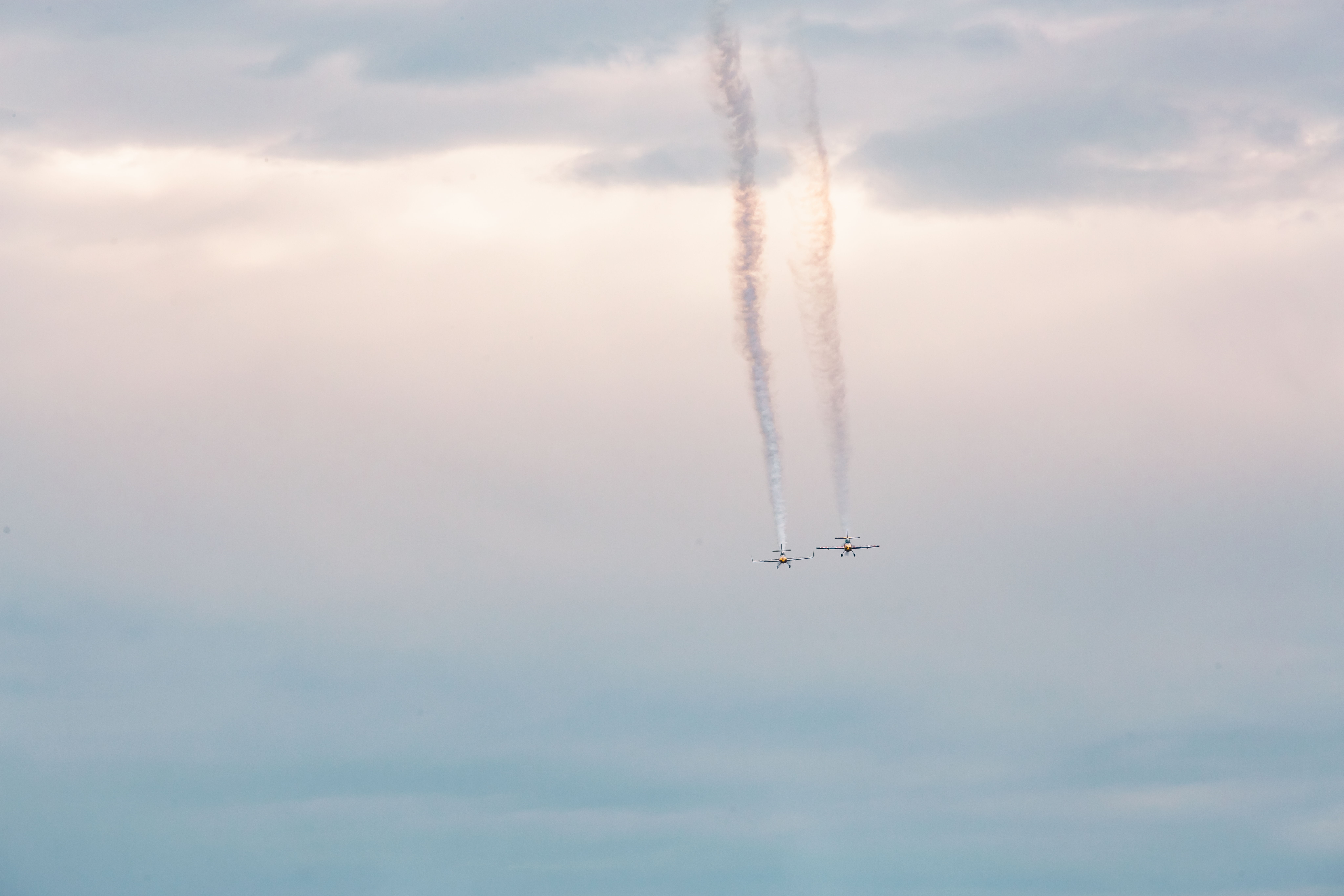
Eddie spent his childhood watching planes take off near his Schofields home in NSW. He’d always dreamt of flying, but couldn’t afford to do so until he was 33. He began with microlights before accelerating through other challenges, from fixed-wing flying to acrobatics, and at 56, he decided to give formation flying a go.
“Most people learn to fly and then become quite solitary,” he says. “You go out to the airport, practise circuits, put your plane back in the hangar and then go home again. Formation allows you to do something with the aeroplane that includes other people, and other aeroplanes.”
Eddie says learning the formation ropes was the “most challenging and humbling thing I’ve ever done”, requiring near endless hours of briefings, walk-throughs, training flights and debriefings. At first, it was incredibly nerve-racking. “The entire time you’ve been learning to fly, one of the primary considerations is to avoid other aeroplanes and suddenly you’re purposely flying next to each other. Initially, that’s very confronting.”
“We’re sitting out there at 2000ft in formation…[and] catch glimpses of all the people on the beach. You get this anticipation, that what is about to happen
Freedom Formation pilot, Eddie Seve
is incredible.”
And there’s nothing more confronting than when two new students take off together for the first time. “The first flight together is scary. You’re so close to another aeroplane and you’re constantly thinking, ‘What the hell is going to happen if we hit?’ But you also have to keep in mind that there are two highly experienced instructors in each plane and those guys don’t want to die, so they will do everything they can to keep you safe.” As a pilot, formation flying is an exhilarating way to keep flight hours up and continuously improve skills. “It’s the most fun you can have with your pants on,” Eddie says with a chortle.
The first day of the 2023 Pacific Airshow the weather wasn’t fine enough, so the Freedom Formation team did a flypast. Then, day two dawns bright and clear. Showtime.
“It’s a surreal experience,” Eddie says. “We launch in groups of four and then form up into a giant 13-ship formation called a Balbo. We’d be in the holding point for the airshow behind the highrises and we’re sitting out there at 2000ft in formation with 13 other guys and you can catch glimpses of all the people on the beach. You get this anticipation, that what is about to happen is incredible.” Touching down his red, black and white Vans RV-7 after 13 adrenaline-filled minutes, Eddie says everyone was “bouncing off the walls”.
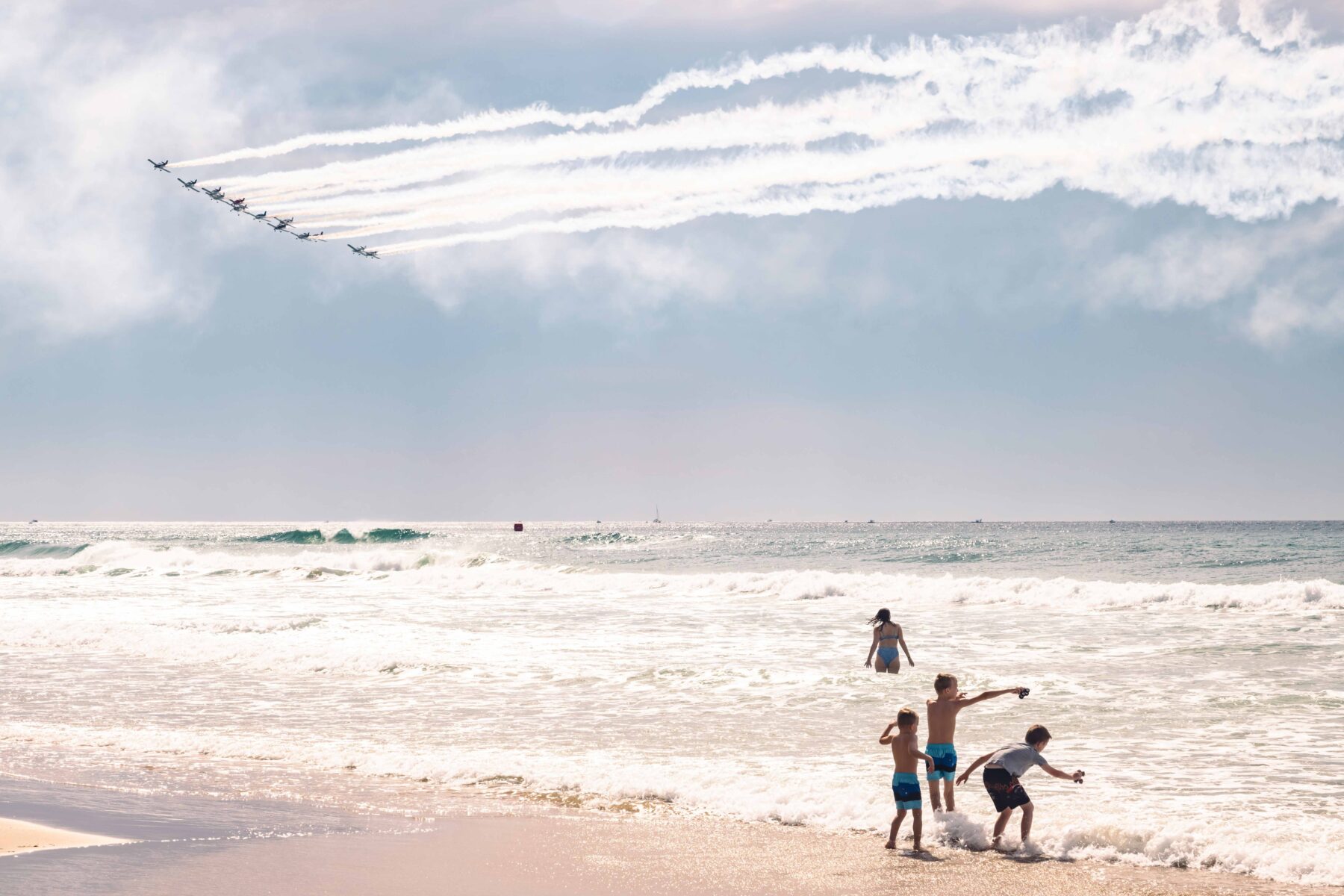
The team, still in their flight suits, drive back to Surfers Paradise for an hour-long meet-and-greet with fans. “Kids were coming up to us asking questions and saying how much they loved the show,” Eddie says. “I never thought I would be signing autographs. Anyone with the motivation and the commitment can do what we’re doing,” he says. “We’re nothing special.”
The Freedom Formation team will be back in 2024, bigger than ever. Another three pilots have thrown their caps into the ring, all complete newbies that will be put through their paces by maestro Jeremy Miller. And Eddie wouldn’t miss it for the world. “Running into the display box, the view is just spectacular,” he says. “The contrast of water, the beach, the people, the highrises…it blows your mind. You couldn’t pick a more stunning location to host an airshow.”
IN MEMORIAM. The Pacific Airshow family was devastated by the loss of friends Major Tobin ‘Smeagol’ Lewis, 37, Captain Eleanor LeBeau, 29, and Corporal Spencer Collart, 21. Thoughts, prayers and deepest condolences go out to their families, loved ones and fellow Marines following their passing one week after the Pacific Airshow Gold Coast. Blue skies and tailwinds.
